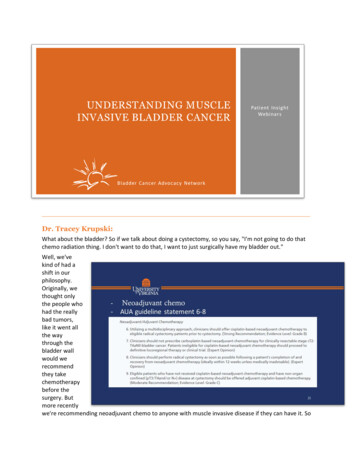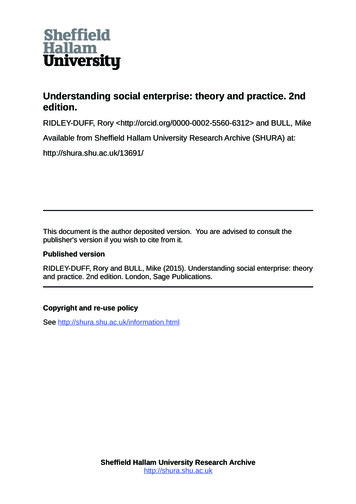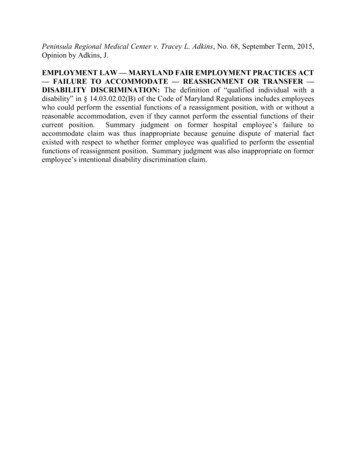
Transcription
Dr. Tracey Krupski:What about the bladder? So if we talk about doing a cystectomy, so you say, "I'm not going to do thatchemo radiation thing. I don't want to do that, I want to just surgically have my bladder out."Well, we'vekind of had ashift in ourphilosophy.Originally, wethought onlythe people whohad the reallybad tumors,like it went allthe waythrough thebladder wallwould werecommendthey takechemotherapybefore thesurgery. Butmore recentlywe're recommending neoadjuvant chemo to anyone with muscle invasive disease if they can have it. So
anyone who comes in with a muscle invasive bladder cancer, it's pretty standard of care to recommendthey discuss chemotherapy with an oncologist.It doesn't mean that you have to take it, there may be medical reasons why you can't get thechemotherapy and you really need to get cisplatin chemotherapy. That's a certain kind of drug. If yousubstitute carboplatin for it, it's not very effective and you should just go ahead and do surgery withoutchemotherapy if you cannot get a cisplatin based chemotherapy. So ideally, that makes this a very longjourney because thischemotherapy usually isgiven for three or fourcycles, which means youget it every three weeksthree times. Soanywhere from 9 to 12weeks, it's going to taketo finish chemotherapy.You need to have a littletime to get stronger sothat you can head intothis big surgery feelinglike you have a goodappetite, good strength,good performance, youcan do things. Those arethe most important criteria. So we would recommend that you discuss it anytime you have muscleinvasive bladder cancer. Now who might not get it? So the cisplatin, this is the drug that I was talkingabout. It's given intravenously. It can be combined either with one other drug called gemcitabine or withthree other drugs and we call that MVAC.Dr. Tracey Krupski:They have neuropathy. So this is the kind of chemotherapy where people are trying to do the buttons ontheir shirt and their fingers don't work as well, they get stiff. It can cause a flare in your gout. But one ofthe bigger things, the two biggest things we worry about is myelosuppression, meaning during thosenine weeks of getting chemotherapy, you're at risk to get an infection because your body is not makingits fighter cells so you may be more likely to it get a pneumonia or a kidney infection or colitis orsomething like that.And if your counts are too low, meaning when they check your blood counts for your leukocytes, yournatural killer cells, all your immune cells, if they're low, they may have to postpone giving you thechemotherapy. And the chemotherapy is not good for kidneys. So when you have impaired kidneyfunction, maybe you've had bad diabetes for a long time, maybe you've had kidney stones, maybeyou've had bad high blood pressure, heart disease. If your kidneys aren't in fairly tip top shape, they'renot going to tolerate getting this drug that is very hard for the kidneys to metabolize. So you have to befit again for chemotherapy also.If your kidney function's not good, if you keep trying to get the drug and your blood counts are so lowthat you're not going to be able to resist any infections, then sometimes you can't get thechemotherapy. But it's always worth discussing these things and talking to the oncologist. And usually Ipersonally would recommend starting it and seeing if you have any of those bad side effects.
The vast majority of patients actually get through this kind of chemo quite well. It's much bettertolerated than some for like chemos for breast or colon cancer or some of the more common ones.There's some data we would generally tell people that you have increased your overall survival by about5% if you take chemotherapy first, and your bladder cancer survival also goes up. So this is over threeyears, it's also over 10 years. And in this other trial, same thing.Dr. Tracey Krupski:If you took thechemotherapy first,the chance of dyingwas 59% with nochemotherapyversus 65% withchemotherapy. Andthen for bladdercancer specific, 35versus 50%. Sogenerally it isimproving overallsurvival to get thechemotherapy first.So we are going totalk a little bitspecifically aboutsurgery andpreparing for the surgery. So if you were to walk in my office, we would sort of have gone through thosethings that we just touched on.First decision youwould have to make is,do we think you shoulddo surgery or do wethink you should gothat chemo radiationroute. If you do chemoradiation, urologist isstill involved becausewe have to do thatmaximal endoscopicresection and thenwe're going to keeplooking in your bladderevery three months. Soyou still see yoururologist, but you willgo see these other doctors. If you say, "Nope, I'm going to get it out. I want that bladder out. I want todo surgery," then your second decision is, should we do chemotherapy or not?
I just gave you groundwork that I would strongly recommend chemotherapy before doing the surgerybut again, you have a personal choice. You can say, "The data doesn't support it for me, I don't want toget chemotherapy first. I want to just do the surgery." Or maybe we look at your kidney function and wesay, "It's really probably not a good idea, it's just going to delay things and it'll probably hurt yourkidneys too much to proceed." So there could be reasons to do chemotherapy or not do chemotherapy.And then the third decisionwe have to talk out is you'regoing to have your bladderremoved, we've decided onchemotherapy, what are wegoing to do with your urineonce your bladder's gone? Sowhat type of reservoir arewe going to put your urinein? And it's a big surgery. Sothe things you have to sort oftalk about, I've alluded to,but when you remove thebladder, it's going to do thebladder, prostate, seminalvesicles for a man, for awoman, you might removepart of the uterus, fallopiantubes, vaginal wall.Dr. Tracey Krupski:This is depending on what your cancer's like, how stuck those organs are together. But the goal is thatyou have to remove anything that might have cancer in it, so that's a consideration. And then for thereservoir, we need to be thinking about what kind of bowel we're going to use and what kind ofreservoir for you you're going to have. So large bowel is going to use your colon, that's going to change alittle bit about your postop life long term.Small bowel, you probably won't notice it as much from a colon or a defecation standpoint, but it'll havedifferent electrolyte abnormalities and different things you'll have to watch for. For you on your day today basis, what matters for incontinent or continent means is the urine just continuously pouring outinto some kind of bag or receptacle, or are you continent, meaning you have to access the bladderthrough some kind of tube, either naturally urinating or potentially putting a tube in you.
So those is what we mean by continent or incontinent. This is the one time I'm the one doctor that getsto tell my kids that geometryactually matters, that I usegeometry in my day to daylife. And what that has to dowith is LaPlace’s Law. If youhave a tube, a long narrowtube like a sausage, thatdoes not store anything.Urine is just going to runstraight through there andthat's going to be anincontinent type of reservoirbecause there's no. Thewall tension is so high it'sjust going to squirt the urinestraight out.Dr. Tracey Krupski:What has to happen if you're going to store urine is you have to create a sphere. So our bladder wasmade into a sphere for a reason. It's not so that the urine comes out better, it's so the urine gets storedbetter. If you have a circular shape, you have a very low pressure wall so that lets the urineaccommodate without constantly having a spasm and squirting out the urine. So anything that we makehas to be made into a sphere if you're going to try to have some kind of continent reservoir.So here's just a cartoony typepicture of the easiest thing forus to make, the easiest thing foryou to take care of but it's thistube, right? The urine justcomes down from the rightkidney, from the left kidney, justgets peristalsis, pushed right outinto the skin and drains into abag on your skin. So this iscalled an ileal conduit orurostomy, very similar tocolostomies that people getthat just continuously drainstool into a bag.This is small intestine so it has the least electrolyte abnormalities and it has the smallest amount of timethat the urine is in contact with the bowel. And that's important for these electrolyte abnormalitiesbecause urine is not supposed to be in contact with the bowel, that's what the urothelial cells were for.So this is an incontinent reservoir called an ileal conduit. And in general, in the United States, this is thevast majority, 60 to 70% of people will have a conduit after this surgery.
Now in Indiana is a continentdiversion. So these arecontinent pouches. I just pickedIndiana, it's the one I make. It'sfairly common but you can hearabout a UCLA pouch and aFlorida pouch and a Kock pouchand a Studer pouch. There'slots of different names, butessentially these are continentdiversions that use colon. Andwe capitalize on the naturalvalve between your smallintestine and your largeintestine, and that's what keepsyou dry.
Dr. Tracey Krupski:So it's a little bit hard to imagine and I don't know that you guys can see my piece of paper. But if youimagine that you have a tube, that's a colon. So this is your colon. We open the colon up away from itsblood supply and then sew it into a bigger circle like that. So again, that's for the storage part. So itbecomes almost kind of like a clam shell. It's somewhat spherical so it will store urine and then youwould put a tube in the one way valve through your skin to empty your urine every four to six hours andthat would be forever.So you have a little medical alert bracelet often. It says I don't have a bladder, my urine comes outthrough my belly button. And that's what this is depicting, what I just tried to do with the piece of paper.You fold this intestine over, you reconnect the regular bowel with all of these. The stool part getsreconnected so you still eat and drink normally, but then you have this valve mechanism that you use toput in through the skin and drain your bladder. So it's a little bit more work for the surgeon, it's a littlebit more work for you.And I put on here chronic loose stools. So what the colon is meant to do is reabsorb water. So itreabsorbs water that you eat and drink on a daily basis. So you're more prone to chronic loose stools ifyou have to use colon to make your continent pouch because now there's no. the whole right colon isused for urine, it's no longer usedfor stool.Neobladder is probably muchmore common these days. Peoplewill try to build you a newbladder. We mostly use smallintestines, so we use ileum also.But you again, have to open upthat tube and sew it by hand intoa circle. And that circle is what'sgoing to allow the urine to bestored and then you have torelearn how to urinate becausethere's no muscle in this intestine.So you relearn how to urinate.Usually it's by relaxing your pelvicfloor. And then occasionally you'llhave to irrigate yourself with themucus from the bowel or if youcan't void successful, you mayhave to empty it through yournatural urethra, either your penisor the urethra for a female.So again, now in this case, it willhave a little different electrolyteabnormalities because the urine isgoing to be sitting in contact withthe intestine and there's going tobe transfer of electrolytes,potassium, sodium, phosphorus,
magnesium because of this new setup where urine is going to be sitting there dwelling between youeither voiding or catheterizing, cetera.Dr. Tracey Krupski:Anytime you have to do morework, there's a few more risks ofthings not totally healing correctlybecause there's a lot more sewingand a little bit more for the patientto learn how to deal withafterwards. But it is a continentand in this case it's attached toyour natural orifice that youcurrently urinate through. So just acouple other pictures in case thesemake more sense. Again, you kindof sew the back wall together, thenyou fold it on itself to make a circle,then there's the ureters comingdown, they drain into this reservoirand then this goes out through thenatural pelvic floor.Bowel, as I just sort of alluded to, isnot meant to be in contact withurine. Postop, one month after anyof these surgeries, 30% ofneobladder patients were quiteacidotic meaning their body pH wasless than 7.4. It can be in the 7.3,7.4s and we sometimes have tosupplement that. Much lesscommon in a conduit because thaturine is just sort of traversingthrough. That's a long termproblem at a year, still up to 25%,the neobladder and 10% of theconduit.So again, you might need extravitamins, you might need to takesome bicarb or citrate. There mightbe things we have to do to adjustthat body pH. If your bicarb in yourblood is less than 15, you do needsupplementation. And these are. ifyour filtration rate is not goodbefore surgery, meaning you don'thave good kidneys before doing
that, we classically are taught that that's not a good person to do this continent bowel reservoir becausethe electrolyte abnormalities are going to be very difficult to manage because the kidneys are what'strying to keep up with those electrolytes, so something to think about.Dr. Tracey Krupski:Even kidney failure can happen in up to a third of patients right after these surgeries and your kidneyfunction will continue to decline for years afterwards again, because we're putting some stress on thekidneys by having this urine be in contact with bowel. Metabolic acidosis, the reason you don't just wantto run around with a chronic acidosis that I'm talking about is it can start to chew up your bones.It tries to offset that bicarb loss bytaking bicarb out of your bones.It'll make any kind of diabetes orendocrine problems with sugarworse. It will accelerate kidneydisease. It will cause musclewasting. You'll lose the albumin inyour bloodstream. So gain, notgreat to stay in an acidotic stateso we do need to treat that, youcan't stay like that. Andmagnesium phosphate, I just sortof alluded to calcium wasting dueto the bone. So again, this isserious, we do have to follow allthese things postop.You don't want to do any kind of neobladder in anybody with cirrhosis, that's sort of just an extra tidbit,not the focus of this. So. Ooh, that was already a lot but this is where you should really be meeting withyour urologic oncologist two or three times before undertaking the surgery because this is not the kindof information that you can go into one visit and have everybody tell you, well, let's talk about removingyour bladder, doing chemo radiation, and do you want chemotherapy?And oh, by the way, the surgery's reallycomplicated and this is all that's goingto happen. This has to be done instages and given time to process it andcome back, ask your questions, think itthrough because it is a major lifechanger and a major surgery. So this isjust a person, a man from the side andjust showing you that the bladder getsremoved, the prostate gets removedand the seminal vesicles. If you're goingto do a neobladder, you would sew tothis urethra and they would still be ableto urinate here.It's showing how close it is to therectum. That's another area we worry about and how your vas deferens will be clipped to do the
surgery. Then the bladder's removed, it's hiding behind the pubic bone, so that's what this is showing.Again, these are all areas where the surgery is complicated. The kidneys have to be rerouted into thispiece of intestine. These are some actual photos of things.Dr. Tracey Krupski:I don't want to dwell on how wewould do the surgery, but itcould be done roboticallythrough some small ports butthe bladder has to be removedsomewhere. So there is anincision to get everything out.This is just a little shot of therobot. The old fashioned way Ihaven't seen. I've never madeone above the belly button.Mostly it's a incision from theside of the belly button downthat does the same thing thatthe robot does.This is a person showing their incision. This is more like it where they have some kind of continentdiversion. This is the incontinent conduit so you can see the urine's just draining straight into a bag ontheir skin. And this is the second belly button I was talking about where you will put a tube in throughthe skin forever more with a continent diversion. So ileal conduit, urostomy is this one. That's the samething, it's just two words for the same thing. Neobladder, this one, he must be hooked up to his naturalorifice. Continent pouch is this one where you can see the second belly button at the skin and you'reputting that tube in through thatbowel, and that's what will drainthe urine. So just to give you a littlebit of a thing. The complicationsare extreme, the list as long as myarm. All kinds of stuff happens afterthis surgery because of what I justtalked about. We're working on alot of different areas, we'reworking on a lot of things and youhave to be aware of thesecomplications and what to look forin the postop period.So I just wanted to touch on thiswas a study that we were part of. Itwas a United States study and theylooked at complications after surgery. We did 15 centers in the country. The patients, we let a coin, itwas a computer decide if they were going to have it done with the robot or have it done the oldfashioned way. And what I wanted to tell you was the complications, whether you were at Mayo Clinic,
Vanderbilt, UVA, UCSF, Harvard,Scottsdale, Cleveland Clinic, it's a bigsurgery and they had adverseevents, meaning some complicationin 67% of the robotic cases and 69%of the open cases, so very high.Dr. Tracey Krupski:The length of stay, how many dayswe're in the hospital. It was six forthe robot and seven for the opencases and the cancer survival or thecure was the same, essentially 72.3versus 71.6. So the robot doesn'tmake it better, the robot doesn'treally change your complications. Itdoesn't change your length of staythat much. It's fine to use it, I'm notagainst it, but you still havecomplications regardless of how youdo the surgery. The surgeon is stilldoing the surgery and has to do allthe appropriate steps.This is that long list of things I justtold you about. What I wanted topull out of that is that ileus meansyour bowels slow down. Bowelsdon't like being taken apart and putback together. So you're in thehospital those five or six days whilewe wait for your bowels to wake upso you can start eating again. Infections were really common in this group. Again, this is data from 15centers across the country, all the best places, it's just a complicated surgery.Infections of the urinary system, infections of the bloodstream, scar tissue between the kidney and theintestines where we sewed that ureter together, atrial fibrillation or heartbeat irregularities, blood clotsthat go to your lungs or your legs, so these were all fairly substantial and 25% of people got readmittedat all these good places. So I am not trying to tell you not to do the surgery. What I am telling you orwhat I tell my patients is that we need open lines of communication and you need to be prepared to letus know if these things are happening.They are all fixable. We can fix them, but the sooner we know about them, the sooner we can fix it. Andif you need to come into the hospital to just get through it, let's come into the hospital, get through it toget you back on your journey and get you back to normal life. You'll read a little bit about enhancedrecovery after surgery. It's a multimodal pathway. We're getting rid of opioids, we don't leave tubesdown your nose anymore. We let you drink Gatorade before surgery. We don't wash out your entireintestine and make you start out dehydrated.
Dr. Tracey Krupski:So it really has streamlinedrecovery and it has minimized thevery severe complications aftersurgery and most people will do anERAS type pathway. These are sortof the highlights that you may haveheard something about. We don'tdo a bowel prep. It's not like acolonoscopy, you don't have todrink all that stuff and makeyourself. have defecate clearliquid. You usually use boosts,nutrition, Gatorade right up to twohours before surgery. We don't useepidurals in your spine anymore.We'll give you multiple painmedications that are not opioids sothat we can try to get your bowelsworking sooner, eat more quickly.And you get educated about all thesteps that are to be expected. Andmost of these will give you fluids athome. So when you go home, wewill set you up to have fluids twoor three times a week to keep thathydration, keep those electrolyteproblems at bay while you'regetting stronger and getting backto your normal self.You'll get these workbooks,worksheets. Again, it's all aboutwhat we expect and what youshould expect so that you knowwhen to contact us.
Dr. Tracey Krupski:You may have a diversion plan thatyou want the neobladder, but yousometimes have to change duringthe operation. We may say thatthere's cancer going into theurethra or the intestine doesn'treach so we can't do a neobladder.If there's a cancer at the margin,those will be reasons not to do it.Again, if you don't want topotentially catheterize yourself orat least be willing to learn just incase, that's going to be aquestionable person to do aneobladder on.If you already have inflammatorybowel disease or problems withdigestion and nutrition, we maynot want to use two or three feetof your intestine to sew in to thiscircle to be your reservoir. Wealways do a node dissection. Thisis kind of to be just quickly, but wewill take all the nodes next to theilea and artery and vein goingdown to this obturator nerve allthe way up towards the iliacbifurcation. So that's what we'reshowing here. At least theselymph nodes on the right pelvisand the left pelvis, some peopleeven do an extended nodedissection all the way up to thecava. That's more surgical thanyou probably need to know.
Dr. Tracey Krupski: If you took the chemotherapy first, the chance of dying was 59% with no chemotherapy versus 65% with chemotherapy. And then for bladder cancer specific, 35 versus 50%. So generally it is improving overall survival to get the chemotherapy first. So we are going to talk a little bit specifically about surgery and










